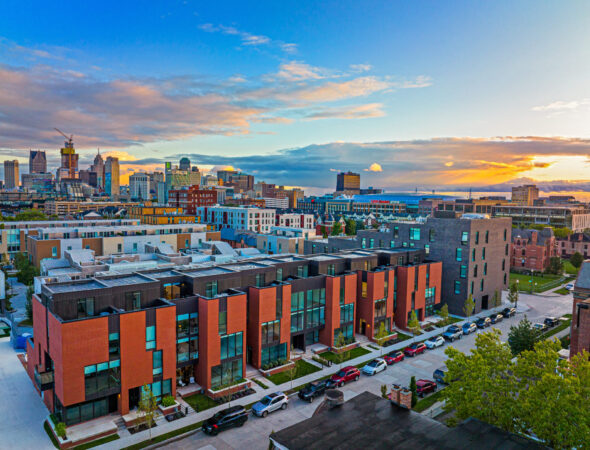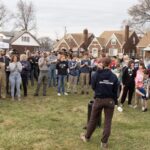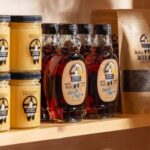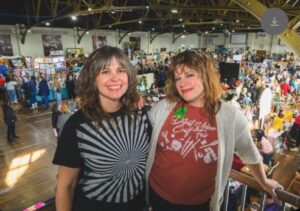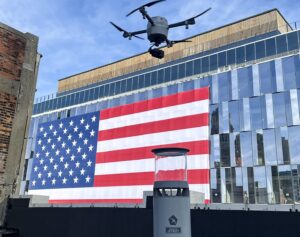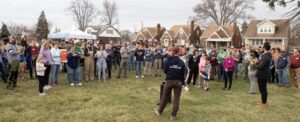Brush Park, one of Detroit’s oldest historic neighborhoods, has a rich and tumultuous past.
Established in 1860, it originally spanned across what was once part of a French ribbon farm, later managed by early civic leaders like Elijah Brush. The neighborhood’s prominence grew in the late 19th century under the influence of Edmund Brush, who named the streets Alfred, Adelaide, Edmund, Eliot, and Brush after family members, and developed the area into an upscale community for Detroit’s elite. Known as “Little Paris,” Brush Park boasted grand Victorian mansions and was home to prominent Detroit figures, including architect Albert Kahn and department store founder Joseph L. Hudson.
As Detroit expanded, Brush Park saw a shift. The advent of the automobile allowed affluent families to move to newer neighborhoods, transforming Brush Park into a mixed-use community. By the 1920s, large homes were subdivided into boarding houses for the city’s working class, including many African Americans moving north for job opportunities. The area became part of a broader Black community near Paradise Valley and Black Bottom, housing significant institutions like the Carlton Plaza Hotel, which served Black patrons during segregation.
The neighborhood changed dramatically in the mid-20th century as “slum clearance” initiatives led to widespread demolition. By the 1960s, Brush Park was nearly abandoned, and historic buildings fell into disrepair. Despite its decline, the neighborhood’s architectural significance prompted preservation efforts. In 1980, the city of Detroit designated it the Brush Park Historic District, sparking a slow but steady revival.
Today, Brush Park is experiencing a renaissance, with many home and building restoration projects and new residents, businesses, restaurants and bars breathing new life into this once-thriving area.
Leading that charge is City Modern – a transformative residential development led by Hunter Pasteur and Bedrock. Spanning eight acres, it blends over 400 new and restored residential units, including townhomes, duplexes, and apartments, to meet housing demand while preserving historic architecture and revitalizing the urban core.
Why Brush Park for this development?
“As we thought about locations for our first foray into a ground-up urban redevelopment in the city, Brush Park’s proximity to the central business district, the arena district, midtown and freeways made it very viable,” said Seth Herkowitz, partner and COO at Hunter Pasteur. “Since we conceived of and began the project, retail has emerged including Grey Ghost, Bar Pigalle, Bodega of Brush Park and more. Overall, there is a lot of investment and growth occurring in this area.”
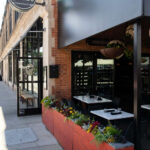
GREY GHOST
Michael Gray, partner of Four Man Ladder and director of operations for Grey Ghost weighs in, saying, “Now there is a plethora of restoration and residential development. It’s a totally different neighborhood than it was when we moved in eight years ago. I’m seeing families with their young kids enjoying the newly renovated park and walking the streets. We didn’t see this even six years ago.”
Olivia Baratta, general manager of the French-inspired restaurant, Bar Pigalle and new resident of Brush Park, highlights the revitalized area as well, saying, “The newly redone park is beautiful, and the entire neighborhood is attracting families, young people, and retirees who are coming together to create a tight-knit, connected community.”
Located on Brush Street a stone’s throw from Pigalle is six-month-old, Spanish-inspired Leña. It’s co-founder – part of Piquette Partners – Tarun Kajeepeta says they chose Brush Park for a couple reasons.
“First, this area of Detroit has quickly built strong residential density and it’s walkable and has a lot of foot traffic,” he says. “And second with the proximity to the stadiums, it draws people from the suburbs, so it’s the best of both worlds. It’s exciting to be part of this thriving area that combines historic properties and very modern developments.
Kajeepeta says they have regulars from the community who all know each other, making it feel like a rich and connected neighborhood.

LENA
Robert Harriman, Operations Manager at Bodega echoes this, saying, “We see residents often and have several regulars that come in. The area is becoming more and more dense.”
Discussing some of the unique challenges their businesses face in Brush Park, the owners point to parking and awareness as ongoing issues.
“The main issue we grapple with is that people coming in from the suburbs often don’t know where to park, so they can feel intimidated by it,” explains Kajeepeta. “Leña, Grey Ghost, Pigalle, Bodega—all these unique spots are tucked in a bit, so we don’t have visibility from Woodward Avenue. We need to keep spreading the word that this great district exists.”
Baratta agrees, adding, “The secret of Brush Park is starting to get out, and I think that will continue as more businesses set up here and more residents move in. Once people experience this area, they tend to love it.”
When asked how they would describe Brush Park to outsiders, each paints a picture of a vibrant, evolving neighborhood.

BAR PIGALLE
Gray says, “When you think of the word ‘neighborhood,’ Brush Park epitomizes it now. It’s tight-knit, mostly residential, and you see familiar faces throughout the week. You know the business owners, and it feels like a classic neighborhood with a unique Detroit touch. It’s up-and-coming, youthful, vibrant, historic, and energetic.”
“It’s rare in a city the size of Detroit to see new ground-up construction in the middle of a historic neighborhood,” says Herkowitz. “There is so much culture blended with new growth which makes it very unique.”
Kajeepeta recommends Brush Park to those who appreciate architecture. “It’s a place where old meets new in a unique way. You see these stunning historic homes next to striking modern buildings, and that mix is rare. It’s also a walkable area with neighborhood hangouts like Bodega, cozy restaurants, and coffee spots.”
Baratta calls it,
The closest thing to a tight-knit neighborhood I’ve experienced in Detroit. You walk outside and see people you know. It’s a friendly, connected place, and it has that ‘cozy corner’ feel – it’s a small slice of Detroit that feels like home.
“It’s a thriving neighborhood that’s walking distance from downtown, which is unique,” says Harriman.
All are optimistic about what lies ahead for Brush Park.
Gray envisions a thriving, populated area, noting, “We’re getting to the point where every block is occupied. Detroit has struggled with population density, and Brush Park is thriving in the best way.”
Baratta adds, “Brush Park is becoming a distinct, all-day neighborhood with spaces where people can walk to and relax and hang out. Businesses keep emerging, people are moving in, and the neighborhood’s sense of connection and vibrancy continues to grow.”
“Brush Park, like many historic neighborhoods throughout the city of Detroit, continues to grow and evolve,” says Herkowitz. “There are still large swaths of land that have been cleared during the last 50+ years and I hope that it will be redeveloped in a thoughtful and contributing way. I think Brush Park’s story remains to be told over many years and decades to come.”
As always, be sure to subscribe to our newsletter for regular updates on all things Detroit.


